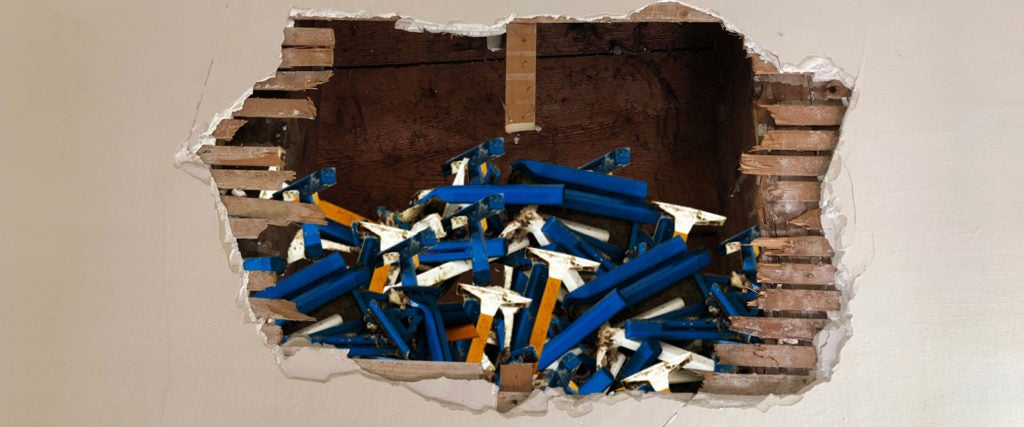Harold Hardesty’s sister was freaking out. She was beginning to renovate the house she’d just bought, but when she cracked open the bathroom wall, hundreds of rusty razor blades tumbled onto the floor. “She thought there’d been a murder, and that she was going to find bones next,” Hardesty tells me.
To his sister’s credit, it wasn’t the craziest assumption. After all, why else would there be a giant pile of old razors hidden behind a wall in an otherwise perfectly normal home?
Luckily, Hardesty’s vast experience as a carpenter in Atlanta kicked in. “I’ve seen this a number of times when remodeling houses,” he explains. “If you find razors in your wall, don’t worry. It doesn’t mean your house was the site of a murder; rather, it’s how people used to dispose of their razors — by sliding them into a slot in their vanity mirror that led inside the wall.”
Hardesty says that back in the early 1900s, when King Camp Gillette’s revolutionary disposable “safety” razors took the country by storm, no one really knew how to dispose of them. “Back then, people would just burn up their trash and spread it around the soil in their garden,” Hardesty tells me. “Razor blades — being metal and all — wouldn’t melt, so that wasn’t a viable disposal method.” What’s more, old blades started to pile up. It would be another 60 years before Gillette developed stainless-steel blades that didn’t immediately dull and begin to rust after their first use.
“The disposal of safety razor blades presents a real and constant problem in almost every home as well as in hotels, Pullman trains and similar places,” inventor Irving Bodkin wrote in his patent application for a razor-blade receptacle. “If left on shelves, the blades rust and become unsightly. … If thrown in waste paper baskets, [there’s] danger of the person removing the waste being cut by the blades. Even if the blades are thrown outdoors, there is still the likelihood of children finding them and sustaining injuries.”
Unfortunately for Bodkin and numerous other inventors, razor-blade receptacles didn’t catch on — mostly because it was much, much simpler to cut a slot in your bathroom wall and dump the old razors into the void. “I know it’s bizarre,” Hardesty says, “but people would slide their razors into the structure of their home. Out of sight, out of mind.”
For what it’s worth, there were a few attempts at recycling the razors: A 1929 issue of Modern Mechanix suggests fastening the old blades together to create a scythe. But two years later, Popular Science highlighted the wall-slot technique in a “Household Tools to Speed Home Work” spread. Eventually, medicine cabinets came with the razor-slot built-in, and for another 40 years Americans filled their wall cavities with aging metal.
Bought a house, 60 year old medice cabinet has a slot to drop razor blades into the wall. from mildlyinteresting
On one hand, shavers of yesteryear were correct in assuming that their razor blades were so thin that it would take centuries to fill the wall completely. On the other, they probably should have considered that the blades would still be there long after the owners were gone. And that the new owners would need to deal with them — somehow.
Installing a shower and re-piping. I had no idea people used to throw razor blades into the wall. The friggin cabinet had a slot for them. from Plumbing
Decades later, carpenters like Hardesty are left picking up the sharp, rusty pieces. “It’s honestly really jarring when you encounter it for the first time,” he laughs. “But it’s nice to know that there’s a perfectly reasonable, or at least somewhat reasonable, explanation for it.”

